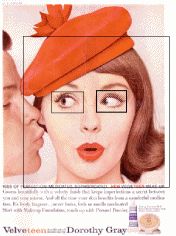
|
Digital Humanities Workbench |
Home page > Data analysis > Visual data Analysis of visual dataThe availability of high quality, high resolution images (as in Rijksstudio) enables the study of visual arts object s that are vulnerable, non-printed or that are part of remote collections. Whereas the analysis of one particular text may benefit from the use of text analysis software (especially if it is a larger text), computer-assisted analysis of individual objects of art usually has no added value over manual analysis. When a collection of images is studied, however, for example to discover certain patterns in the material in question, the use of digital tools may prove to be of value.
Qualitative analysis When dealing with a compact, manageable collection of which all individual items can be studied, software can be used to annotate the images. Apart from describing metadata (title, creator, collection, etc.), such annotations can be both descriptive (e.g. indicating specific objects on a picture, or the use of colours) or interpretative.
When dealing with a compact, manageable collection of which all individual items can be studied, software can be used to annotate the images. Apart from describing metadata (title, creator, collection, etc.), such annotations can be both descriptive (e.g. indicating specific objects on a picture, or the use of colours) or interpretative.
Software tools like Atlas.ti (for both free and formal annotation; available at VU University) and UAM Image Tool (for formal annotation; a bit older, but freeware) not only offer facilities for annotating images on various levels, but also for managing the annotations (e.g. creating annotation groups and hierarchies) and for analysis. Atlas.ti, for example, has features for searching for images with certain annotations, combining images with shared annotations, model building, different types of analyses, etc. Because of these features, these tools can support the analysis of the images in various ways.
Further reading: Automatic image analysisWhen dealing with larger collections, with sets of collections that have different locations or with more diffuse collections, manual annotation and/or analysis of each individual object is often not possible. In those situations, automatic image recognition may be employed to identity and detect an object or a feature in a digital image (or video).In most applications, the focus is on image retrieval. Two important techniques for this are automatic image annotation and content-based image retrieval , which are defined by Wikipedia as follows (retrieved on 11-5-2017): Automatic image annotation (also known as automatic image tagging or linguistic indexing) is the process by which a computer system automatically assigns metadata in the form of captioning or keywords to a digital image. This application of computer vision techniques is used in image retrieval systems to organize and locate images of interest from a database. [Source] Content-based image retrieval (CBIR), also known as query by image content (QBIC) and content-based visual information retrieval (CBVIR) is the application of computer vision techniques to the image retrieval problem, that is, the problem of searching for digital images in large databases (…)."Content-based" means that the search analyzes the contents of the image rather than the metadata such as keywords, tags, or descriptions associated with the image. The term "content" in this context might refer to colors, shapes, textures, or any other information that can be derived from the image itself. [Source]
Recently, also the automatic analysis of images in large collections is receiving great interest. Visual data analytics is a branch of big data analytics and is part of the field of cultural analytics, where massive cultural data sets of visual material are not only explored but also analysed. |
Other topics in this section: Introduction Textual data Conversation Structured data |
